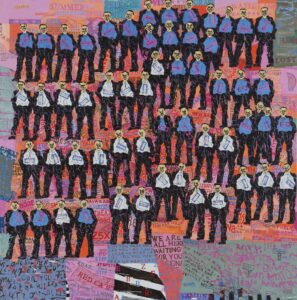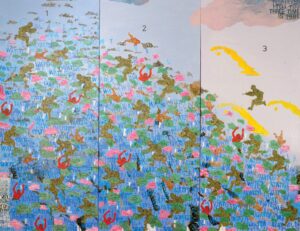Currently Empty: ₨0.00

Arpita Singh is a prominent artist in the ambit of Indian Modern Art. Her unparalleled endeavour positions her amidst the country’s pantheon of great masters, a standing rarely achieved by women of her generation. Born in 1937 at Baranagar, a north Calcutta suburb of undivided Bengal, Arpita moved to Delhi with her brother and mother following her father’s demise. A long journey brought her to the city of Delhi. In 1954 she received admittance to the School of Art in Delhi Polytechnic and pursued a Diploma course in Fine Arts concluding in 1959. After graduation she worked as an Art Designer at the Weavers Service Centre in Calcutta and Delhi. While there, her interaction with traditional artisans and weavers majorly influenced her and cast an enduring impression in the subsequent years of her arts practice.
The 1960s was a difficult time in India for the progression of arts practice. Artists had to rely on alternative professions like teaching in schools and colleges to support themselves. Arpita with fellow artists like husband Paramjit Singh, R.K. Dhavan, Eric Bowin and others formed a small group called ‘The Unknown’. They exhibited regularly with money collected amongst themselves. In 1963 Arpita exhibited for the first time at the Kunika Chemould Art Centre in Delhi with a show commemorating her mentor Sailoz Mukherjea. Over the years she participated in several other exhibitions there followed by her first solo show in 1972.
A constant negotiation of grit and creative perseverance allowed the artist to advance in her career – all the while experimenting with novel visual vocabularies. Arpita’s early 1960s paintings comprised of semi-abstract compositions in oil, gradually moving onto stark black and white abstraction of the 1970s. The artist explains this shift –“The change was conscious. I decided that I wanted to concentrate on drawing. I did not have much money to experiment with multimedia. So I settled for figures in black and white.” The experimentation was triggered by exercises in woodcuts and incorporated dense planes with jagged-line motifs, resulting in a large body of paper drawings in ink and watercolour. Close observance of this series reveals the artist’s ingenuity in divulging the essence of formal abstractionism through intricate fabrication of textural surfaces, suggestive of the rhythmic crisscross of woven tapestry. She grew fascinated by the pure aesthetics of dots and lines and the endless possibilities they projected. The dots appeared like ‘‘a ritual – a mantra – that removed movement blocks’’ on the canvas surface. The practice exhumed her native traditions of kantha stitches (quilt embroidery) and alpana (making designs on a surface with rice- paste) that merged tiny dots and lines into a rhythmic synchronization of pattern.
The 1980s saw a significant change in her visual vocabulary. The dots and lines receded to accommodate subjects of everyday life. Larger issues of humanity found as much validity in her creative domain as intimate details of domesticity. Her canvases became celebratory records of her personal space within the larger sphere of public domain. Simple metaphors like chairs, carpets, teapots and tablecloths; habitual acts of reading newspapers, stitching, drinking tea – gained magnitude in an amalgam of parallel realms of internal and peripheral worlds. The artist alluded to her feminine identity as the starting point of eloquent discourses and fashioned her creative passage through candid comments from the feminine perspective. The insinuations interchanged between comic and tragic elements to build a dramatic strain in denoting the position of women in society. Employing a manner of depiction that was – part naïve and part real – she assayed the growing intolerance, violence and injustice witnessed in society. The pictorial space became a mingling of allegorical elements like guns, flowers, telephones, furniture, road-maps and vehicles. The notion of a journey became integral to her imagery, represented through ubiquitous motifs. They perhaps reflect memories of a journey she had made several years before from her birth place to the city of her dwelling conjuring a shared history of dislocation. Her pursuit of gene pools and human migration urged her to delve into archaeological and mythological legacies. Her process promotes layers of myth and fantasy; re-contextualizing ancient connotations in the present times, and interweaving personal and collective history.
This act of layering is reiterated in the physical process of developing a painted surface. Short patches of overlapping tones and pigments (oil and water colours) applied in studied fortitude create an unusual surface tension. To achieve this dexterity Arpita underwent several stages of experimentation. Her oeuvre ranged from smooth compositions of flat surfaces and sharp contoured outlines (reminiscent of popular bazaar art) to a more subdued palette of multiple textured forms, aided by skilful brush manipulation on wet to dry surfaces. Surface treatment held a special significance for the artist who felt it had the power to reveal inner harmony and balance. Fellow artist Nilima Sheikh acknowledged this unquenchable zest for perfection stating – “More than any other artist in India, Arpita Singh is heir to Amrita Sher-Gill’s legacy of enriching the surface of oil painting.”
An enchanting persona of gentle demeanour Arpita Singh exemplifies the passionate candour of her female protagonists – the strong middle-aged woman rising amidst margins of domesticity. The artist has been felicitated with the Parishad Samman from Sahitya Kala Parishad (1991) and the Padma Bhushan – highest civilian honours from the Government of India (2011). She continues to actively pursue her creative journey rendering pensive compositions that seems to defy her age in their vigour and annotations on the eternal flow of life.
By Moutushi Chakraborty
Images Caption
My Lollipop City : Gemini Rising,
60 x 84 inches,
oil on canvas,
2005
Tree,
19 x 28 inches,
watercolour on paper,
2005
Zebra Crossing: We are all waiting for your signal,
60 x 60 inches,
oil on canvas,
2011
My Lily Pond,
84 x 108 inches,
oil on canvas,
2009
A Man with a paper roll,
14.5 x 11 inches,
watercolour on paper,
2009
The Moth,
36 x 24 inches,
oil on canvas,
2013
R.G. Comes back from morning walk,
14 x 10 inches,
watercolour on paper,
2012
Women in Blue, Men in Black,
16 x 12 inches,
watercolour on paper,
2007





